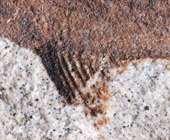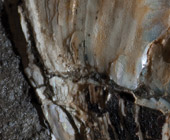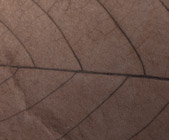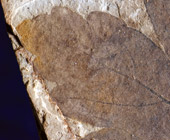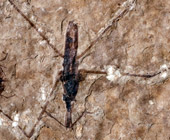by Ashley Demedeiros, Third-year Bachelor of Journalism
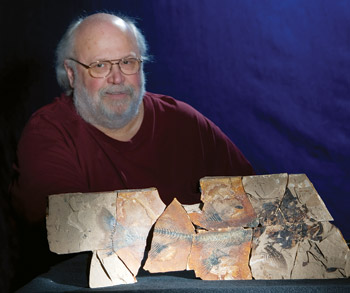
Ken Klein, Paleontologist, TRU Instructor and founding president of the Thompson Nicola Paleontology Society. Photos by Bob Clark.
At first glance the sand, dirt, rocks and clay that compose Kamloops’ landscape look, at best, well-suited for the back drop of a Hollywood western. Beneath the surface of those rolling hills are hints to a story that was played out millions of years ago, a plot line that is revealed with erosion, time, chiseling, some dusting and a lot of patience.
“We have had researchers from all over North America… Holotypes have been named – species not yet found anywhere else in the world.” – Ken Klein
The actors in the stories are the fossils found preserved within the earth, pried from beneath millenniums of silt. They chronicle the life in the region before it was the Thompson Valley, millions of years ago.
Measured in geological time, it was a comparative nanosecond ago when 15 years ago, a few like-minded fossil finders created the Thompson-Nicola Paleontology Society.
Ken Klein, instructor in TRU’s Geology Department, was founding president of the society leading the group for about a decade. “The BC Paleontology Alliance had been around for about a year and they were holding their first symposium in Courtenay and they asked me to present a paper. They also asked me if I was interested in starting a regional society and I agreed,” recalls Klein of how the Paleontology Society came into existence.
“I knew a few people around town, like the owners of the McAbee site and the rock club and just let them know we were starting a club,” Klein says. “We also put together displays at the Aberdeen Mall to get people interested.”
Since then, the amateur paleontologists not only have kept the local club active, but have been regularly meeting at TRU and working with Klein on identifying and archiving the specimens, because as he says, “The society was founded on the premise that it is good science to have amateurs with the time and resources do the collecting.”
Although the club hasn’t found anything larger than 50cm in size, the collection contains spectacular specimens of fish, plants, insects and even rarer – crayfish and birds. “What is exciting about Kamloops is the diversity of species,” says Rick Tucker, the current president of the Thompson-Nicola Paleontology Society.
The 50.2 million-year old McAbee Fossil Beds holds untold troves of Eocene-era treasure. Located on Highway 97 between Kamloops and Cache Creek, the site is run by Dave Langevin and Robert Drachuk. They open the site from May to October and during the busy summer months of July and August, offer daily guiding. They guarantee everyone will find a fossil to take home, but if the finds are of scientific significance, they are asked to donate them to TRU.
“The McAbee site down by Cache Creek is world renowned. It’s a superb site to visit,” Tucker says. More than superb, during the 50 years the beds have been actively accessed by collectors, many Holotypes – fossils of brand new species – previously unknown in the world – have been discovered.
It’s with mixed feelings that Klein views the operation of the McAbee site as a tourist destination.
“There are reasons to protect sites and reasons to allow for responsible collecting. I have to sit on the fence. I am a supporter of protecting important sites, and McAbee is an important site, but despite criticism by other scientists in the field, I have a great deal of trust in the current McAbee claim holders, who have turned over significant finds to the university. If they find something important they hold on to it and several times a year they bring in the collections for donation.”
Between what the day-trippers dig up, the specimens found by the society and the fossil finds from around the province, TRU, through Klein’s perseverance has amassed a significant collection of fossils – a collection he estimates to number in the thousands and large enough to have evolved into the TRU Institute for Paleontology Research. “We began the Institute with the donation of fine fossil bird and a huge collection from the McAbee claim holders. Dedication took place when TRU hosted BC Paleontology Symposium in 2001.”
“We have had researchers from all over North America access the collections and much has been published. Holotypes have been named – species not yet found anywhere else in the world,” said Klien.
The fossils are housed in a room on the second floor of the science building near the geology lab. “The institute is still in the introductory stages and consists mainly of a room full of storage units of specimens. It is not like the museum downtown (Kamloops), it is just a room,” says Klein. “Our biggest headache is space. We need at least 10 or more cabinets (and a larger room) to store the fossils at a cost of some $50,000.”
In spite of space issues the institute has started creating a digital database. Last summer TRU funded a museum archive program for the Institute and once it is up to date it will be a major archiving database that other schools and universities will be able to access.

The fossils are housed in a room on the second floor
of the science building near the geology lab.

